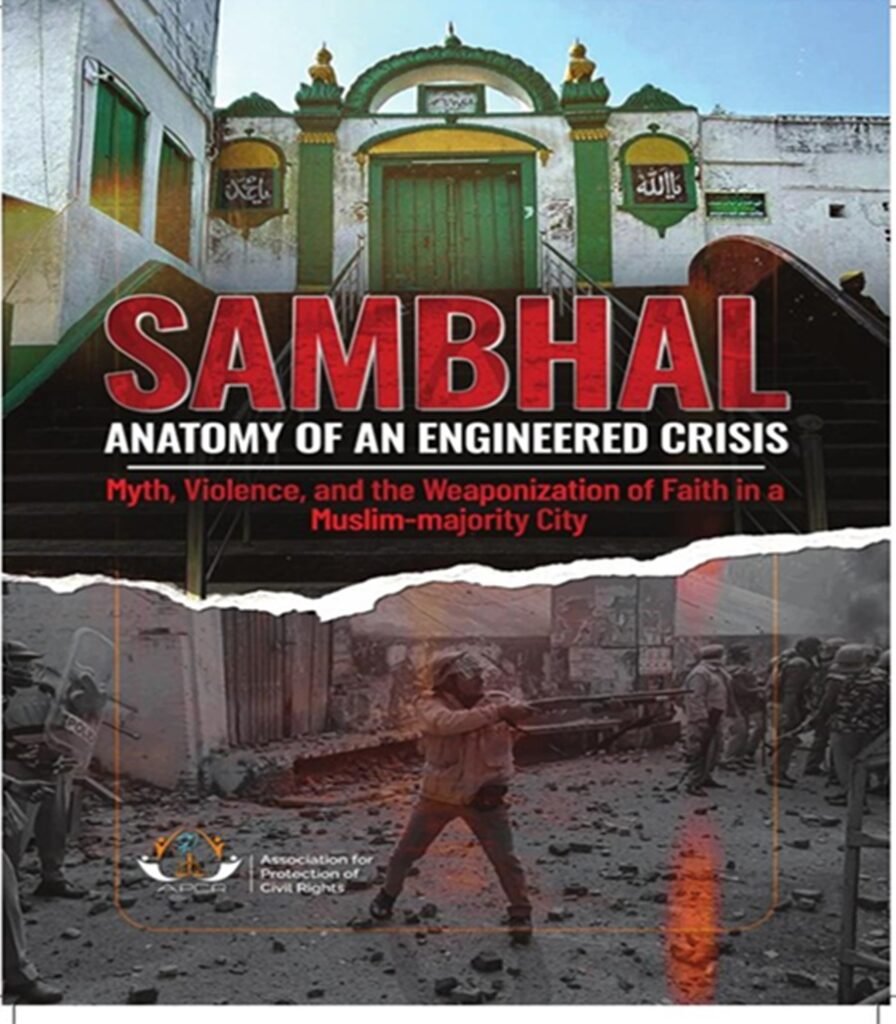APCR and Karwan-e-Mohabbat jointly release report and documentary; families, lawyers, and activists demand justice and transparency
NEW DELHI — A detailed report and a documentary on the violence last November in Sambhal, Uttar Pradesh, allege that administration bias, police excesses, arbitrary arrests, and a selective use of the law resulted in five deaths and created a sense of fear and insecurity in the Muslim community.
The Association for Protection of Civil Rights (APCR) and Karwan-e-Mohabbat jointly released the report “Sambhal: Anatomy of an Engineered Crisis” and the documentary “Sambhal Mosque Killings” at the Press Club of India in the national capital on Tuesday.
The event included a panel discussion and testimonies from survivors, activists, and lawyers. The findings revealed disturbing facts about police action, religious targeting, and denial of justice.
Nadeem Khan, National Secretary of APCR, questioned the events that led to the violence. He said, “We are releasing this report six months after the violence to ask why two surveys were conducted without a proper process, why a slogan-chanting mob was allowed into the mosque, and why the community was not consulted. This selective use of the law led to five deaths in Sambhal,” he said.
The violence began after a local court ordered a sudden survey of the Shahi Jama Masjid on 19 November 2024. A second survey, conducted on 24 November, included the presence of a loud mob and actions seen as insulting to the mosque, which triggered large protests.

Shavez, a resident and school manager, shared his ordeal. “Many innocent people have been jailed. They are from poor families and haven’t even been granted bail. Part of my school was taken over without notice. When I tried to resist, I was threatened, and even legal papers were rejected until I went to the high court. Things are only getting worse,” he said.
Prakriti, a researcher from the fact-finding team, described her experience. “We were watched at all times during our visit. Police were already present when we reached the victims’ homes. This looked like a test of total control using power and fear. We saw demolitions and refusal to accept genuine documents,” she said.
Well-known activist Harsh Mander, who led the fact-finding and made the documentary, questioned the historical claims used to justify the unrest. “Suddenly, people claim that Sambhal is the birthplace of Kalki. How far are we going to go in history to justify violence? If you dig a mosque, you find a temple. Dig a temple, and you find a stupa. Where does it end? Sambhal had no record of Hindu-Muslim clashes. Now they are trying to turn it into another Ayodhya,” he said.
Advocate Ahmad Ibrahim spoke about the legal concerns. “We filed a case asking if police followed rules on 24 November. There is no evidence of guns with the protestors. If police fired, then we need a report on who died and why. No answers have come yet. If the law were applied fairly, this would never have happened,” he stated.
Reading from the report, Navsharan Singh described it as “deeply disturbing.” She said, “Girls were arrested without women police officers present. Five people were found dead three days later. Families had to sign blank papers to get back the bodies. The internet was shut down, and no one was allowed to visit Sambhal. The whole area was under lockdown. Even after death, there was no respect.”
Journalist Saba Naqvi stressed the need to document such incidents. “This story must be recorded. Otherwise, such tragedies will be forgotten. The report is a great effort in telling the truth”, she said.
Congress MP Imran Masood ended the event by expressing concern over the state of democracy. “People in Sambhal were scared. Who fired the bullets? Laws should be equal for everyone. But the current environment in our country is not democratic. Even YouTube channels are restricted. They want to keep spreading hate for years to come,” he said.
Key Findings of the Report:
• Police responded with lathis, tear gas, and bullets, killing five Muslim men, including minors.
• Over 85 people were arrested; many were poor and had no access to legal aid.
• Eyewitnesses said protestors were peaceful, but faced house raids, beatings, and property destruction.
• Postmortem reports were delayed, and lawyers were denied access.
• Police outposts were built using stones from the protest site, and posters accused innocent people.
• Claims about Kalki’s birthplace and new religious tourism were promoted, raising fears of religious rewriting.
The report concludes that the violence could have been avoided. Basic steps like peace meetings and crowd control rules were ignored. Many say the events remind them of the time before the Babri Masjid demolition.
APCR said that this report is part of its larger effort to fight hate crimes and stand with victims of violence.

